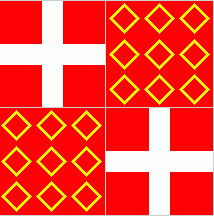 image
by Klaus-Michael Schneider, 22 October 2008
image
by Klaus-Michael Schneider, 22 October 2008
Last modified: 2013-06-29 by rob raeside
Keywords: sovereign and military order of malta | emmanuel de rohan de polduc | rohan de polduc | grandmaster |
Links: FOTW homepage |
search |
disclaimer and copyright |
write us |
mirrors
 image
by Klaus-Michael Schneider, 22 October 2008
image
by Klaus-Michael Schneider, 22 October 2008See also:
Flag of Grandmaster Emmanuel de Rohan de Polduc (1775-1797)
It is a
quarterly divided square flag. The 1st and 4th quarter are showing the white
Greek cross in a red field of the Order of St. John. The 2nd and 3rd quarter are
showing the personal arms of the grandmaster. In a red field are nine red
diamonds ordered three times three and fimbriated golden (= yellow). Flag is
hoisted upon the mainmast.
Source: Capt. Joseph M. WISMAYER: “The fleet of
the order of St. John 1530-1798”, Midsea Books, Valetta(?) 1997; ISBN
99909-75-30-2; front page.
Klaus-Michael Schneider, 22 October 2008
The city of Żebbuġ, Malta, is sometimes
represented by the coat of arms of SMOM Grand Master Rohan, after whom it was
named. Evidence of such use was posted at
http://www.haz-zebbug.com/storja_kavallieri.htm, and although the image in
question was not stored by Archive.ORG, its alt text is visible as "The old coat
of arms of Haz-Zebug", clearly meaning the city, not its magisterial patron.
António Martins-Tuválkin, 7 June 2007
 image
by Klaus-Michael Schneider, 22 October 2008
image
by Klaus-Michael Schneider, 22 October 2008
Flag of Grandmaster Emmanuel de Rohan de Polduc (1775-1797) (plain flag)
It
is a rectangular flag. In a red field are nine red diamonds ordered three
times three and fimbriated golden (= yellow). Flag is stuck upon railing at port.
Other sources of the coat of arms are showing the diamonds connected with one
another, forming a golden lattice.
Source: Capt. Joseph M. WISMAYER: “The
fleet of the order of St. John 1530-1798”, Midsea Books, Valetta(?) 1997; ISBN
99909-75-30-2; frontpage
Klaus-Michael
Schneider, 22 October 2008
Gules nine mascles or are the arms of the family of Rohan. In
crystallography, a macle (cognate to German Masch, mesh) is a complex crystal
made by the reunion (by interpenetration of juxtaposition) of several crystals
of the same kind but with different geometrical orientations; in heraldry, a
mascle is a lozenge voided by a smaller lozenge in the middle. Philippe Rault
writes in Les drapeaux bretons [rau98] that macled crystals are common in the
Breton forest of Quenecan, which belonged to the family of Rohan until the
Revolution, and might have been the origin of the coat of arms of the family.
The mascles of Rohan are found in several Breton coat of arms, for instance the
municipal arms of Landivisiau,
Crozon and Loudéac.
Ivan Sache, 22 October
2008
According to this webpage
http://www.smom-za.org/smom/grandmasters/70.htm:
"Grand Master
Emmanuel de Rohan (1775-97) was a different type of man. He was a French
aristocrat and did his best to revive the principles and the tenets of the
Order. But it was too late. The decline of the Order had already began and
could not be stopped. The Knights were a new generation and had long
circumvented their monastic vows and the vows of poverty. The Ottoman Empire
was on the wane and the original motivation of the Order had become
superfluous. Incidents between the Knights and the Maltese people were frequent
during de Rohan's troubled days. The ships of the Order were a magnificent
spectacle, gorgeous and majestic, but no longer suited for the time. This was a
period of decay and to replenish his depleted treasury he had to resort to
selling these vessels to the Kings of Naples and Spain. After the French
Revolution the Order was despoiled of its property in France, though de Rohan
had rightly refused to join the French against England who was mistress of the
sea. Throughout his rule the Grand Master did his best to save the Order from
total destruction and to further the well-being of the Maltese people. No
wonder, therefore, that when he died desolation spread throughout the island."
Santiago Dotor, 15 March 2006